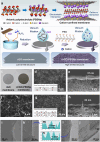Electrostatic-induced ion-confined partitioning in graphene nanolaminate membrane for breaking anion-cation co-transport to enhance desalination
- PMID: 38773152
- PMCID: PMC11109394
- DOI: 10.1038/s41467-024-48681-8
Electrostatic-induced ion-confined partitioning in graphene nanolaminate membrane for breaking anion-cation co-transport to enhance desalination
Abstract
Constructing nanolaminate membranes made of two-dimensional graphene oxide nanosheets has gained enormous interest in recent decades. However, a key challenge facing current graphene-based membranes is their poor rejection for monovalent salts due to the swelling-induced weak nanoconfinement and the transmembrane co-transport of anions and cations. Herein, we propose a strategy of electrostatic-induced ion-confined partitioning in a reduced graphene oxide membrane for breaking the correlation of anions and cations to suppress anion-cation co-transport, substantially improving the desalination performance. The membrane demonstrates a rejection of 95.5% for NaCl with a water permeance of 48.6 L m-2 h-1 bar-1 in pressure-driven process, and it also exhibits a salt rejection of 99.7% and a water flux of 47.0 L m-2 h-1 under osmosis-driven condition, outperforming the performance of reported graphene-based membranes. The simulation and calculation results unveil that the strong electrostatic attraction of membrane forces the hydrated Na+ to undergo dehydration and be exclusively confined in the nanochannels, strengthening the intra-nanochannel anion/cation partitioning, which refrains from the dynamical anion-cation correlations and thereby prevents anions and cations from co-transporting through the membrane. This study provides guidance for designing advanced desalination membranes and inspires the future development of membrane-based separation technologies.
© 2024. The Author(s).
Conflict of interest statement
The authors declare no competing interests.
Figures






Similar articles
-
"Cation-Recognition" Effect of 2D Nanochannels in Graphene Oxide Membranes Intercalated with Ionic Liquid for High Desalination Performance.Small. 2025 Feb;21(7):e2406550. doi: 10.1002/smll.202406550. Epub 2025 Jan 2. Small. 2025. PMID: 39745131
-
Polyoxometalate Clusters Confined in Reduced Graphene Oxide Membranes for Effective Ion Sieving and Desalination.Adv Sci (Weinh). 2024 Sep;11(36):e2402018. doi: 10.1002/advs.202402018. Epub 2024 Jun 17. Adv Sci (Weinh). 2024. PMID: 38887207 Free PMC article.
-
Electroregulation of graphene-nanofluid interactions to coenhance water permeation and ion rejection in vertical graphene membranes.Proc Natl Acad Sci U S A. 2023 May 9;120(19):e2219098120. doi: 10.1073/pnas.2219098120. Epub 2023 May 1. Proc Natl Acad Sci U S A. 2023. PMID: 37126725 Free PMC article.
-
Lithium-Ion-Sieve-Embedded Hybrid Membranes for Anion-Exchange- and Cation-Concentration-Driven Li/Mg Separation.ACS Appl Mater Interfaces. 2024 Dec 11;16(49):66911-66920. doi: 10.1021/acsami.3c19100. Epub 2024 Feb 21. ACS Appl Mater Interfaces. 2024. PMID: 38381533 Review.
-
Molecular modeling of thin-film nanocomposite membranes for reverse osmosis water desalination.Phys Chem Chem Phys. 2022 Dec 14;24(48):29298-29327. doi: 10.1039/d2cp03839k. Phys Chem Chem Phys. 2022. PMID: 36453147 Review.
Cited by
-
Overcoming Challenges in Colloidal and Chemical Stability of Graphene Oxide with Exploration of Dispersing Solvent.Small. 2025 Jul;21(29):e2502991. doi: 10.1002/smll.202502991. Epub 2025 May 19. Small. 2025. PMID: 40384219 Free PMC article.
-
Electrostatic-driven dehydration of ions in nanoporous membranes.Sci Adv. 2025 Aug 29;11(35):eadv0174. doi: 10.1126/sciadv.adv0174. Epub 2025 Aug 29. Sci Adv. 2025. PMID: 40880460 Free PMC article.
References
Grants and funding
LinkOut - more resources
Full Text Sources

